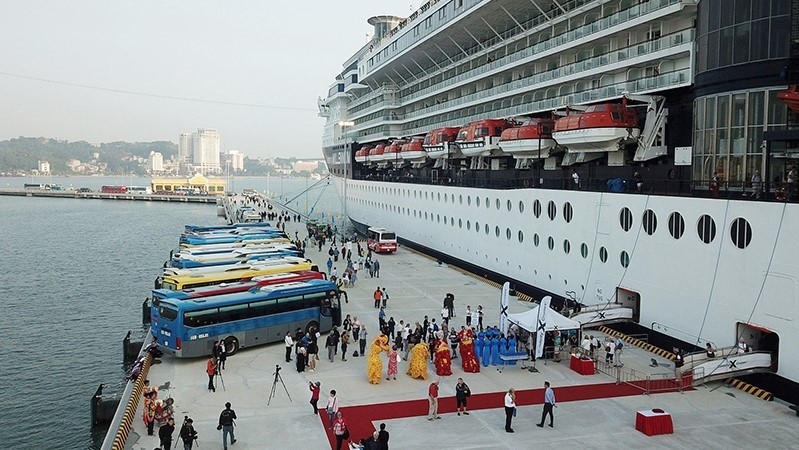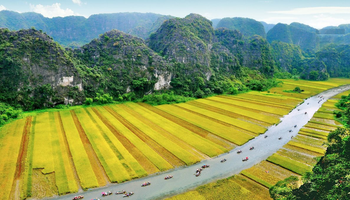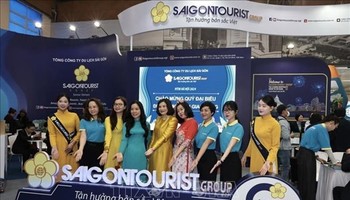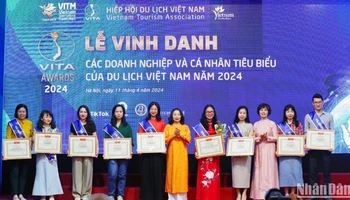The sector lost around US$23 billion because the number of international visitors and domestic tourists decreased by around 80% and 50%, respectively, compared with last year.
However, the social distancing period due to COVID-19 provided the “necessary time off” for the tourism sector to review the limitations as well as seek opportunities among challenges and formulate solutions for sustainable development in the new period.
A year of heavy losses
Entering 2020, Vietnamese tourism has gained momentum and a foundation of spectacular growth for five consecutive years. In January 2020, Vietnam welcomed two million international visitors during a month for the first time. However, since February, the outbreak of COVID-19 pandemic in the world immediately affected the country’s tourism. Vietnamese tourism sector had to face unprecedented difficulties. Vietnam has postponed welcoming international visitors since March. Meanwhile, the domestic tourism market was also affected by social distancing. The Ministry of Culture, Sports and Tourism (MoCST) forecasted that Vietnam receive around 3.8 million international visitors in 2020, down nearly 80% from the previous year; meanwhile, the number of domestic tourists has decreased by nearly 50%.
Around 40-60% tourism workers lost their jobs or reduced their working days; approximate 95% international travel businesses stopped their operation; and many hotels had to close. The tourism sector’s total losses are estimated at up to VND530 trillion (around US$23 billion).
Re-evaluating internal resources
The COVID-19 pandemic forced the tourism sector to focus on the development of domestic tourism. The sector had to simultaneously perform “dual tasks” that ensuring the safety of people’s lives and health while maintaining production and business. The promotion of domestic tourism is the only solution for enterprises to gradually maintain their operation and recover. The MoCST has twice launched domestic tourism promotion programmes,s themed “Vietnamese people travel Vietnam' in May and “Safe and attractive Vietnamese tourism” in September. The programmes have received the proactive response from localities, enterprises and people. Thanks to great efforts, the number of domestic tourists reached 49 million by the end of November. Domestic tourism has contributed to maintaining the sector’s operation during the period of epidemic prevention and control.
The unimaginable devastation of the COVID-19 pandemic made Vietnamese tourism sector to re-evaluate and rethink its operation in the context of complicated epidemic. The exploitation of domestic tourist market has been enhanced in a “new normal” state, with the prerequisite requirement of ensuring safety for tourists and products. However, the sector should prepare measures and new products to meet international visitors as soon as it is eligible to re-welcome international visitors.
At many forums and conferences on tourism, the relevant agencies reviewed and deeply evaluated the weaknesses and limitations of Vietnamese tourism that were revealed clearly through the pandemic so that they proposed solutions to recover the operation. Firstly, the sector should quickly restructure the tourist market. Recently, Vietnam's tourism has depended too much on the East - North Asia market (including China, Japan and the Republic of Korea) which accounted for around 66.8% of total international visitors. Meanwhile, several markets of tourists with high spending (such as Europe and America) have not been exploited effectively. Therefore, the tourism sector should make adjustments in creating proper products that can meet the diverse demands of international visitors, especially “rich” ones. In addition, it is essential to ensure the balanced development of international visitors from various markets as well as improve the quality of products and business efficiency. According to statistics, the average stay of international tourists to Vietnam is only 8.1 days, with an average spending of US$1,074 for the trip (significantly lower than in Thailand). This is an issue that requires the tourism sector to have solutions related to products and directions to prioritise attracting high spending and long-term stays, ensuring sustainable development of tourism in Vietnam, and paying more attention to the domestic tourist market.
According to experts and management agencies, it is very necessary to restructure the tourism market so that domestic tourism will become an important market (contributing 55%-75% of the total revenue of the sector within the next two or three years). For a long time, due to the insufficient attention to the domestic tourist market; therefore, the revenue from domestic tourists only accounted for less than 45% of total revenue of the tourism sector. The exploitation of the domestic tourism market with 100 million people will a stable and sustainable income source for the sector.
In the context of COVID-19 prevention and control, the cooperation and tourism linkage has been promoted by the localities, becoming an important measure in increasing the number of domestic tourists. The enhancement of linkage among regions, localities, agencies and enterprises; the improvement of tourism products’ quality; and assurance of safety for tourists are key solutions. The localities worked together to identify appropriate and attractive products for each region to avoid competition by similar products or conflicts. The cooperation for tourism development between Ho Chi Minh City and eight North West provinces was a typical example. Earlier, Ho Chi Minh City has held effective tourism linkage activities with 13 Mekong River Delta provinces and five South-Eastern provinces.
Another important measure is the restructuring of products and creation of new and unique products. The experience from the recent domestic tourism stimulation programmes was the enhancement of promotion activities for destinations, especially new places, and the connection between them to create new, unique and attractive products. In launching new products, the enterprises should offer commitments on delaying, cancelling and changing tours and services to ensure interests of visitors in all situation. This is also a creative step of Vietnamese businesses in a “new normal” state.
Finding opportunities among challenges
Vietnam is implementing the “dual goals” of preventing and combating COVID-19 while boosting socio-economic development. The proposal of concrete and feasible solutions to recover domestic tourism and open international market when conditions permit is the core goal of Vietnam's tourism sector.
At the 2020 National Conference on Tourism themed “Linkage, action and development” held in Quang Nam in late November, the representatives from the Government, ministries, agencies, localities and major tourism enterprises discussed and proposed measures to revive the country’s tourism following the end of pandemic. The short-term and immediate solution proposed by businesses was the policies to support the tourism sector and enterprises to overcome difficulties. In addition, radical and long-term solutions were also discussed.
Experts and representatives from the businesses agreed with four groups of measures that were proposed by the MoCST: restructuring the tourist market in a sustainable and effective manner towards the markets with high-quality and high-spending tourists; developing new products and services while enhancing the linkage, diversification and improvement of the products’ quality in line with each market segment; strengthening the public-private cooperation and linkages among localities and destinations in the cooperation for tourism development; and accelerating digital transformation, especially in market research, database and tourism promotion. The MoCST noted that among these solutions, digital transformation in tourism development, especially in management, business, market research and tourism product marketing, is a vital requirement. Therefore, the Ministry proposed the Government’s assignment to lead the development of a Master Plan on digital transformation for tourism sector until 2030.
The COVID-19 pandemic remains complicated and unpredictable around the world. According to the World Tourism Organisation, the global tourism is forecast to recover as early as the third quarter of 2021. The whole enterprises, localities and management agencies have joined hands to restructure the tourism sector of Vietnam, especially the source of visitors and suitable products to receive new opportunities. The breakthroughs and creativities in developing tourism during the COVID-19 outbreak will be the foundation to create momentum for the sector to find opportunities among challenges, continuing to affirm the position of Vietnam’s tourism sector.
















